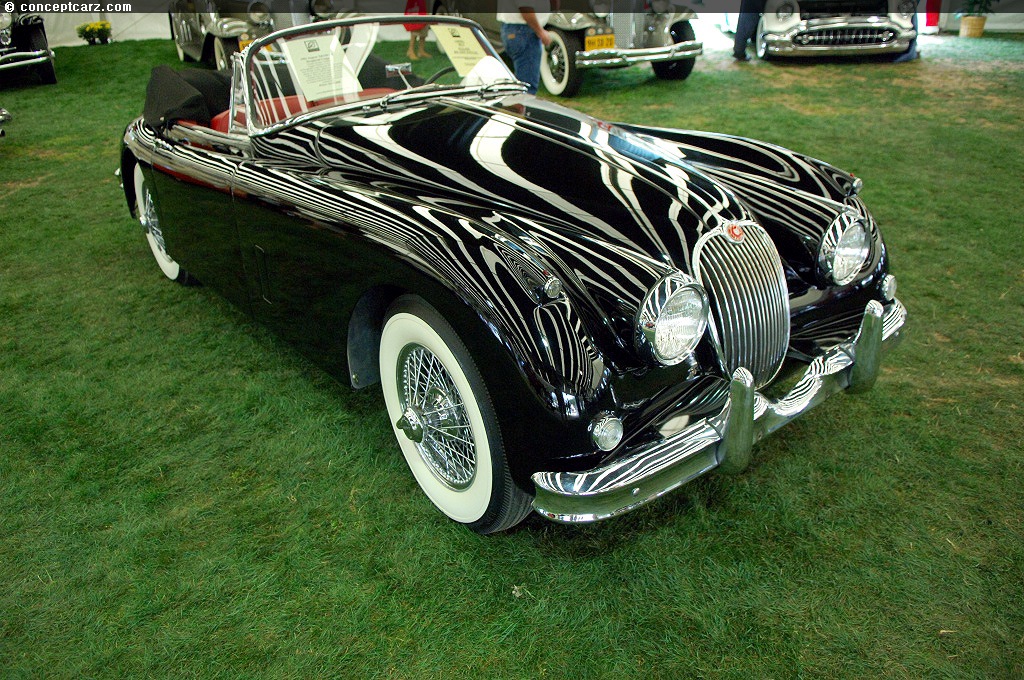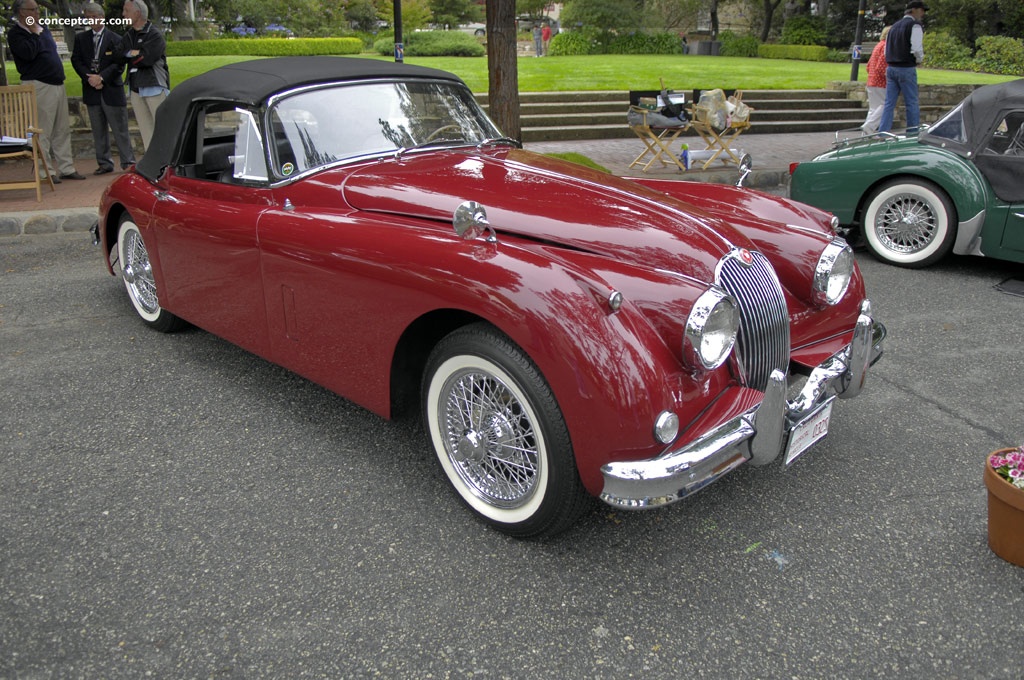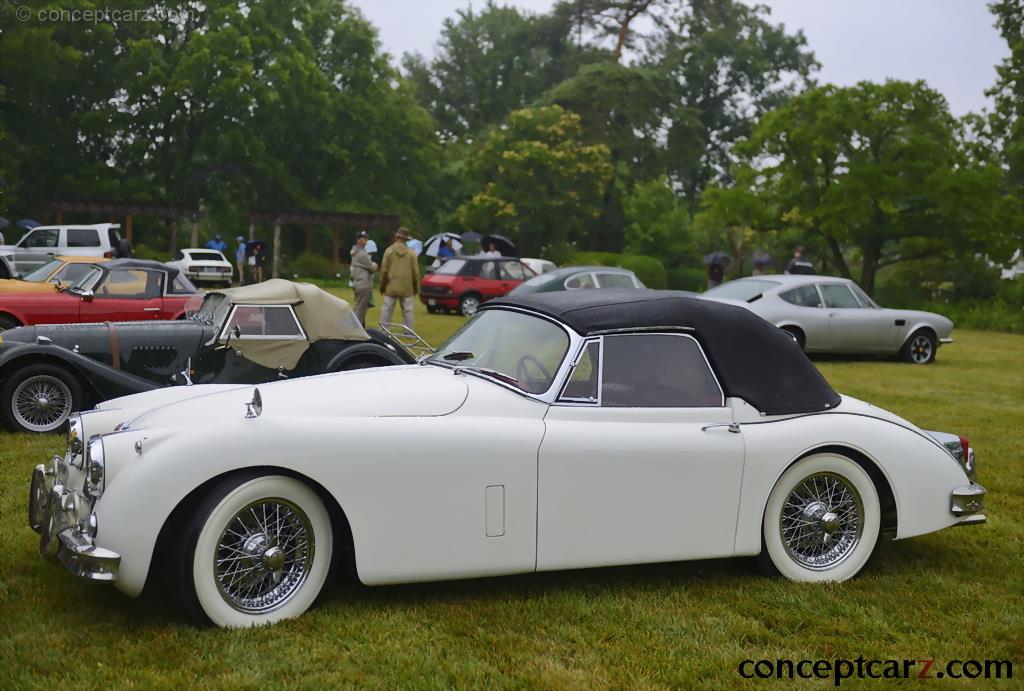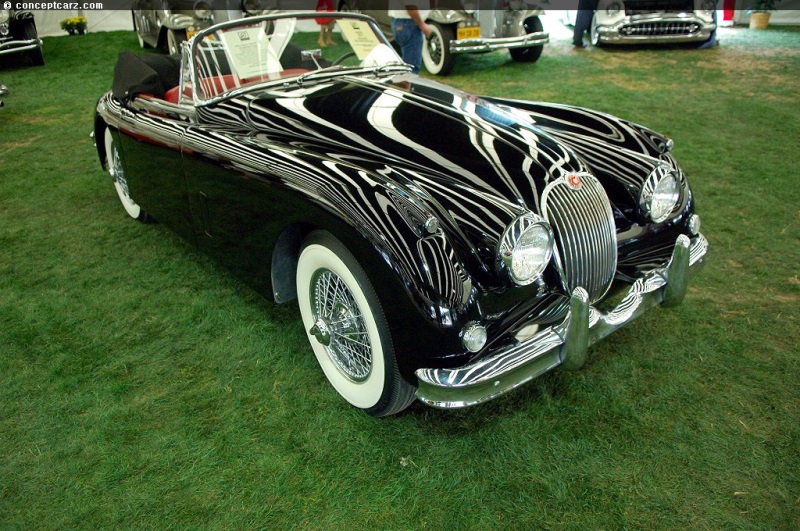The Jaguar XK150 was introduced a decade after the arrival of its predecessor, the XK120, yet retained a strong family resemblance on the outside while embracing tremendous mechanical changes underneath. The XK140 that was built between the XK120 and XK150, was a transitional model, while the XK150 was a thorough updating of the XK look with a styling progression that moved Jaguar from the 1940s into the 1960s. The small glass area of the previous cars was greatly enlarged for improved visibility and modernized with a one-piece wraparound windshield design. The slab-sided body and thin doors were very modern, and the interior room and comfort were dramatically increased. For the first time, larger real roll-up glass windows were used, and Jaguar's Le Mans boot badge was updated with an ever-growing list of victories. The interior did away with the previous high-maintenance wood veneer, opting instead for an entirely new roadster-style aluminum and padded leather dash. Front-wheel disc brakes were standard on all XK150s, a big improvement over the previous drum brakes, which would experience 'fade' following repeated stops from high speed. With the disc brakes installed, the XK had stopping power to match its prodigious straight-line speed.
Convertible S
Chassis #: S838990
Engine #: VA2155
View info and historyThe Jaguar XK150 was announced in its home market in May 1957 and production would continue through 1961, with 9,382 examples built during that time. The much-admired chromed Jaguar mascot was made available as an optional extra on an XK for the first time.Mechanical Specification
The X-frame chassis had a 102-inch wheelbase, an overall length of 177 inches, and was 62.2 inches wide. Although it used the same basic chassis as its predecessor, its body was wider and although it used many XK120/140 pressings, the increase was achieved by means of a 4-inch wider central fillet. A higher front wing line and broader radiator grille were other visual differences. The suspension and chassis were similar to the XK140, with an independent front setup with wishbones and a torsion bar, while the rear relied on a live axle with half-elliptic leaf springs. Steering was via a manual-only rack and pinion system. In 1960, four-wheel Dunlop 12-inch disc brakes became optional. Factory specification 6.00 × 16 inch Dunlop Road Speed tires or optional 185VR16 Pirelli Cinturato CA67 radials could be installed on either 16 × 5K½ solid wheels or optional 16 × 5K wire wheels.XK Engine
The William Heynes designed 3.4-litre Jaguar XK double overhead camshaft inline-6 engine was similar to the XK140's, but with a new 'B' type cylinder head that boosted output to 180 (SAE) bhp at 5,750 RPM. It had double SU HD65 carburetors and the bore measured 83 mm and the stroke of 106mm.
Convertible S
Chassis #: J61S838987DN
View info and historyA fire at the factory in February 1957 caused a twelve-month delay of special equipment models with the more potent SE engine and disc brakes. Upgrades included a modified B-Type cylinder head with larger exhaust valves and twin 1.75-inch SU HD6 carburetors which helped increase output to 210 (SAE) BHP at 5,500 RPM and, even more noticeably, an 11% increase in torque. Most of the export cars received the SE improvements. The open two-seater could also be purchased with an 'S' engine which had three 2-inch SU HD8 carburetors and a straight-port cylinder head, bringing output to 250 (SAE) bhp. In 1960, engineers took the 3.8-liter engine from the full-sized luxury Mark IX saloon and placed it into the bay of the XK150. This optional engine delivered 220 bhp in standard guise and 265 bhp in 'S' models. 
Convertible
View info and historyOverdrive and a Borg-Warner automatic gearbox were the transmission options, the latter becoming an increasingly popular choice, while a Thornton Powr-Lok limited-slip differential was available for the XK150 'S'. Body Styles
Body styles included a fixed head coupe (FHC) and a drophead coupe (DHC), with a roadster version arriving the following year, in 1958. The Drophead coupes had a neater rear decklid than previous examples, along with unique chromed rain gutters and the convertible top had been styled to work harmoniously with the XK150's lines. It sealed tight to repeal water but could also fold swiftly into a compact, well-engineered bustle, complete with a tonneau.Production
By the time production ceased in October of 1960, a total of 9,382 examples of the XK150 had been built. The most popular was the fixed head coup with 4,445 units built, followed by 2,672 of the drophead coupe and 2,265 of the roadster.
Convertible
Chassis #: S837285
View info and history
Auction entries : 3The XK150 was the final glorious incarnation of Jaguar's fabulous 'XK' series of sports cars.
by Daniel Vaughan | Jun 2023

Convertible S
Chassis #: S838990
Engine #: VA2155
View info and history
The X-frame chassis had a 102-inch wheelbase, an overall length of 177 inches, and was 62.2 inches wide. Although it used the same basic chassis as its predecessor, its body was wider and although it used many XK120/140 pressings, the increase was achieved by means of a 4-inch wider central fillet. A higher front wing line and broader radiator grille were other visual differences. The suspension and chassis were similar to the XK140, with an independent front setup with wishbones and a torsion bar, while the rear relied on a live axle with half-elliptic leaf springs. Steering was via a manual-only rack and pinion system. In 1960, four-wheel Dunlop 12-inch disc brakes became optional. Factory specification 6.00 × 16 inch Dunlop Road Speed tires or optional 185VR16 Pirelli Cinturato CA67 radials could be installed on either 16 × 5K½ solid wheels or optional 16 × 5K wire wheels.XK Engine
The William Heynes designed 3.4-litre Jaguar XK double overhead camshaft inline-6 engine was similar to the XK140's, but with a new 'B' type cylinder head that boosted output to 180 (SAE) bhp at 5,750 RPM. It had double SU HD65 carburetors and the bore measured 83 mm and the stroke of 106mm.

Convertible S
Chassis #: J61S838987DN
View info and history

Convertible
View info and history
Body styles included a fixed head coupe (FHC) and a drophead coupe (DHC), with a roadster version arriving the following year, in 1958. The Drophead coupes had a neater rear decklid than previous examples, along with unique chromed rain gutters and the convertible top had been styled to work harmoniously with the XK150's lines. It sealed tight to repeal water but could also fold swiftly into a compact, well-engineered bustle, complete with a tonneau.Production
By the time production ceased in October of 1960, a total of 9,382 examples of the XK150 had been built. The most popular was the fixed head coup with 4,445 units built, followed by 2,672 of the drophead coupe and 2,265 of the roadster.

Convertible
Chassis #: S837285
View info and history
Auction entries : 3
by Daniel Vaughan | Jun 2023
Related Reading : Jaguar XK150 History
In 1957 Jaguar introduced the XK150, a replacement for the XK140. The XK140 had been a replacement for the XK120 which had started the XK series with its elegant styling and impressive 120 mph capabilities. At the time, the XK120 was the fastest production vehicle in the world. The XK150 had many similarities to its predecessors but it featured modern styling and improved mechanics. When the XK150....
Continue Reading >>
Continue Reading >>
Similar Automakers
Similarly Sized Vehicles
from 1961
Similarly Priced Vehicles
- Mercedes-Benz 190 SL ($5,030-$5,245)
- Triumph Italia 2000 ($5,000-$5,000)
- Jaguar MKII ($4,910-$4,910)
- Oldsmobile Starfire ($4,640-$4,640)
- Ford Thunderbird ($4,175-$5,440)
- Lancia Appia ($2,851-$4,870)
- Chrysler New Yorker ($4,130-$4,870)
- AC Ace ($4,800-$6,600)
- Mercedes-Benz 220 Series ($4,280-$8,090)
Average Auction Sale: $94,287
1961 Jaguar XK150 Vehicle Profiles
Recent Vehicle Additions
Performance and Specification Comparison
Price Comparison
$4,910
$5,599 - $5,890
$6,080
XK150 Specification Comparison by Year
Year
Production
Wheelbase
Engine
Prices
Related Automotive News

Ford Celebrates Diversity Of Road And Race Performance Line-Up Past And Present At Goodwood Festival Of Speed
Hermann Salenbauch from Ford Performance and Larry Holt from Multimatic to make a special Ford GT announcement, 0945 BST, July 4, at the Goodwood Festival of Speed
Ford Performance road car debuts at Goodwood include the all-new Focus ST in actio...

A New Automotive Icon To Debut At Le Mans – First DB4 GT Zagato Continuation Set For Unveil At Circuit De La Sarthe
DB4 GT Zagato Continuation to make public debut at 24 Hours of Le Mans 2019
Race-goers will be first to see Aston Martins most expensive new car
DB4 GT Zagato Continuation extends Zagato bloodline in centenary year
11 June 2019, GaydonLe Man...

Excellence Reborn – Work Under Way On Iconic DB4 GT Zagato Continuation
First body completed as DB4 GT Zagato Continuation build commences at Aston Martin Works
Modern production systems meet artisan coachbuilding skills as Aston Martin optimises Zagato build process for 21st Century
DB4 GT Zagato Continuation extends...

DBZ Centenary Collection: Classic Joins Contemporary In Unique Centenary Tribute
DBZ Centenary Collection comprises of DB4 GT Zagato Continuation and DBS GT Zagato
Production strictly limited to 19 pairs - cars will not be sold separately
Conceived to mark Zagatos centenary in 2019
Track-only DB4 GT Zagato Continuation to be...

DB4 G.T. CONTINUATION: HISTORY IN THE MAKING
Iconic DB4 G.T. brought back to life by Aston Martin Works
Cars will be built at Newport Pagnell - home of the original DB4 G.T.
Strictly limited to 25 track-only cars
Newport Pagnell production re-starts after 10 years
09 December 2016, Newp...






















